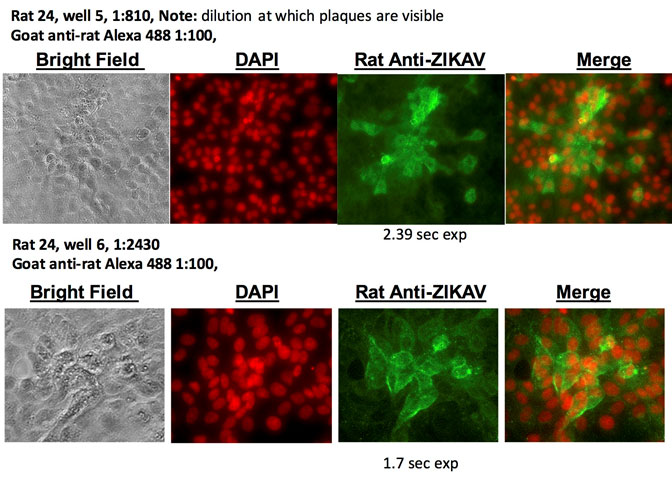Anti-Zika Virus (PRVABC59) [Rat#24] Antibody
This rat polyclonal antibody was raised against live whole zika virus infection, formalin-fixed virus boost and recognizes zika virus.
Highlights:
- Recognizes whole zika virus
- Rat was not pregnant and was infected with 106 PFU Zika, strain PRV59ABC/Puerto Rico/Human/Dec 2015
- Suitable for IFA and VN titer applications
Zika virus (ZIKV) is a member of the virus family Flaviviridae and the genus Flavivirus, transmitted by daytime-active Aedes mosquitoes. Zika is related to other mosquito transmitted viruses such as dengue, yellow fever, Japanese encephalitis and west nile. Similar to other flaviviruses, ZIKV is enveloped and icosahedral and has a nonsegmented, single-stranded, positive-sense RNA genome. Common symptoms of infection with the virus include mild headaches, maculopapular rash, fever, malaise, conjunctivitis, and joint pains. Zika has been shown to cause microcephaly in babies exposed in utero.
From the laboratory of Mark S. Parcells, PhD, University of Delaware.
This rat polyclonal antibody was raised against live whole zika virus infection, formalin-fixed virus boost and recognizes zika virus.
Highlights:
- Recognizes whole zika virus
- Rat was not pregnant and was infected with 106 PFU Zika, strain PRV59ABC/Puerto Rico/Human/Dec 2015
- Suitable for IFA and VN titer applications
Zika virus (ZIKV) is a member of the virus family Flaviviridae and the genus Flavivirus, transmitted by daytime-active Aedes mosquitoes. Zika is related to other mosquito transmitted viruses such as dengue, yellow fever, Japanese encephalitis and west nile. Similar to other flaviviruses, ZIKV is enveloped and icosahedral and has a nonsegmented, single-stranded, positive-sense RNA genome. Common symptoms of infection with the virus include mild headaches, maculopapular rash, fever, malaise, conjunctivitis, and joint pains. Zika has been shown to cause microcephaly in babies exposed in utero.
From the laboratory of Mark S. Parcells, PhD, University of Delaware.
| Product Type: | Antibody |
| Antigen: | Zika, PRVABC59 (Human/Puerto Rico/2015) |
| Accession ID: | A0A142I5B9 |
| Clonality: | Polyclonal |
| Clone Name: | Rat#24 |
| Reactivity: | Zika virus |
| Immunogen: | Live whole virus infection, formalin-fixed virus boost |
| Species Immunized: | Rat |
| Method Used to Determine Concentration: | Immunofluorescence (IFA) |
| Buffer: | Whole serum |
| Concentration: | IFA titer 1: 810 |
| Storage: | -80C |
| Shipped: | Dry Ice |
Epifluorescence using a Nikon TE-2000 scope, with NIS-Elements software

If you publish research with this product, please let us know so we can cite your paper.

![Anti-Zika Virus (PRVABC59) [Rat#24] Antibody Anti-Zika Virus (PRVABC59) [Rat#24] Antibody](https://www.kerafast.com/MediaStorage/Product/Images/Medium/1574_2001202001265315730.jpg)
